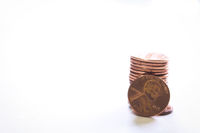Posted on February 15, 2021

The coin commonly known as the U.S. penny is formally known as a 'one-cent piece.' [1] It may be small in denomination, but the one-cent coin carries great nostalgia. Although the future of the penny has become uncertain, this coin will always retain value for collectors who appreciate its meaning.
The United States penny has changed over the years. The easiest way to follow its evolution is by looking at it through each new release. The biggest changes centered around its design and sometimes its minting.
The first American penny, known as the 'Fugio cent,' was reportedly designed by Benjamin Franklin. It features a sun and sundial on one side and a chain with 13 links, representing the original colonies on the reverse. [1] The Fugio cent was nearly 50% larger and more than five times heavier than the modern penny. [2]
The United States Mint was established in 1792, and the first penny was minted the following year. [3] The Flowing Hair cent was the first coin of any metal that the federal government mass-produced, even using its own machinery. The nation's first circulating coins from the mint were 11,178 copper cents, released on March 1, 1793. [10] This coin was reduced in size from 264 grams of copper to 208 grams. [4] It features the image of a woman with flowing hair on one side and a circular chain on the other. [3, 4]
In 1857, the Mint began mixing nickel with the copper used for the cent in an attempt to reduce production costs. [3, 11] The Flying Eagle cent was composed of 88% copper and 12% nickel. [2] This coin was smaller and named for the flying eagle on one side. The reverse side featured a wreath.
The Indian Head cent replaced the Flying Eagle cent in 1859. This coin has an Indian princess on the obverse. After the Civil War, the Coinage Act of 1864 made this one-cent coin (and subsequent pieces) legal tender. The coin's composition changed again in 1864 to contain 95% copper and 5% zinc. [2]
The Wheat Ears Cent replaced the Indian Head Cent in 1909. Also known as wheat pennies, these were the first coins to feature Abraham Lincoln. The 16th president of the United States was minted on the penny in honor of his 100th birthday. Most wheat pennies were made primarily from copper, but some were minted from steel in 1943 to save copper for cartridge casings in World War II. [5]
The Lincoln Memorial Cent was produced from 1959 to 2008. This coin was introduced to celebrate President Lincoln's 150th birthday. It features a new reverse designed by Frank Gasparro that showcases the Lincoln Memorial.
These pennies were originally made from 95% copper and 5% tin and zinc. In 1982, the composition of the penny changed to copper-plated zinc. From that point forward, pennies were made from 97.6% zinc and just 2.4% copper. The appearance and size of the coin are otherwise identical to those made primarily from copper. [6]
There is usually a minimum of 25 years required between new coin designs. However, the 2009 Lincoln Bicentennial One Cent Program permitted four design changes in a single year. 2009 marked 200 years since Lincoln's birth and 100 years since the first Lincoln cent was produced.
All four designs minted this year feature Lincoln on the front. The backs of the coins highlight Lincoln's:
Most of these coins were made from copper-plated zinc. However, a special collector's version was made from 95% copper and 5% zinc and tin. [7]
In 2010, the Lincoln penny received its most recent redesign to feature a shield on the reverse. This symbolizes Lincoln's preservation of the U.S. as a united country. [3]
The one-cent coin has become obsolete in many countries. Australia withdrew its one-cent coin in 1992, and New Zealand followed suit in 2006. Canada minted its last penny in 2012. Some organizations argue that the United States should follow suit, citing some compelling facts from various financial and environmental reports:
In light of the 2020 coin shortage, [9] the end of the penny may loom near. However, there are still many opposed to retiring the penny, stating that this could increase prices if they're rounded up. The penny also holds great nostalgia and significant meaning with its imagery. Only time will tell the future of this coin.
Article Sources
1. History.com. '10 Things You Didn't Know About the Penny,' https://www.history.com/news/10-things-you-didnt-know-about-the-penny. Accessed August 11, 2020.
2. Americans for Common Cents. 'A Brief History of the U.S. Cent,' https://pennies.org/a-brief-history-of-the-u-s-cent/. Accessed August 11, 2020.
3. United States Mint. 'Penny,' https://www.usmint.gov/learn/kids/library/circulating-coins/penny. Accessed August 11, 2020.
4. PCGS. 'Type 1, Chain Cent,' https://www.pcgs.com/coinfacts/category/half-cents/flowing-hair-large-cent/type-1-chain-cent-1793/656. Accessed August 11, 2020.
5. Coin Values. 'The History of Wheat Pennies,' https://coinvalues.com/blog/the-history-of-wheat-pennies. Accessed August 11, 2020.
6. U.S. Department of the Treasury. 'History of the Lincoln Cent,' https://www.treasury.gov/about/education/Pages/lincoln-cent.aspx. Accessed August 11, 2020.
7. United States Mint. 'Lincoln Bicentennial One Cent Program,' https://www.usmint.gov/learn/kids/library/lincoln-bicentennial-cents. Accessed August 11, 2020.
8. World Finance. 'Are we witnessing the death of pennies?' https://www.worldfinance.com/strategy/are-pennies-about-to-cease-to-exist. Accessed August 12, 2020.
9. The New York Times. 'Will the Penny Survive Coronavirus? Some Hope Not.' https://www.nytimes.com/2020/07/29/business/coin-shortage-penny.html. Accessed August 12, 2020.
10. United States Mint. 'The History of U.S. Circulating Coins,' https://www.usmint.gov/learn/history/us-circulating-coins. Accessed August 13, 2020.
11. PCGS. '1856-1864 Copper-Nickel Cents,' https://www.pcgs.com/news/1856-1864-copper-nickel-cents. Accessed August 13, 2020.